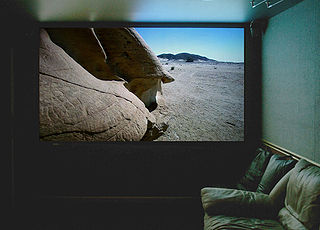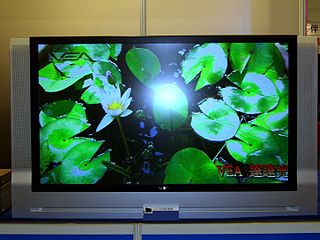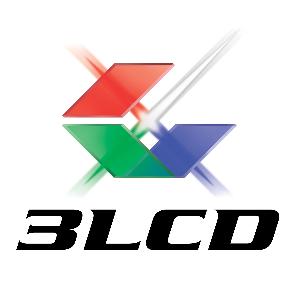Related Research Articles

Home cinema, also called home theaters or theater rooms, are home entertainment audio-visual systems that seek to reproduce a movie theater experience and mood using consumer electronics-grade video and audio equipment that is set up in a room or backyard of a private home. In the 1980s, home cinemas typically consisted of a movie pre-recorded on a LaserDisc or VHS tape; a LaserDisc or VHS player; and a heavy, bulky large-screen cathode ray tube TV set, although sometimes CRT projectors were used instead. In the 2000s, technological innovations in sound systems, video player equipment and TV screens and video projectors have changed the equipment used in home cinema set-ups and enabled home users to experience a higher-resolution screen image, improved sound quality and components that offer users more options. The development of Internet-based subscription services means that 2016-era home theatre users do not have to commute to a video rental store as was common in the 1980s and 1990s

An overhead projector (OHP), like a film or slide projector, uses light to project an enlarged image on a screen. In the overhead projector, the source of the image is a page-sized sheet of transparent plastic film with the image to be projected either printed or hand-written/drawn. These are placed on the glass surface of the projector, which has a light source below it and a projecting mirror and lens assembly above it. They were widely used in education and business before the advent of video projectors.

A transparency, also known variously as a viewfoil, foil, or viewgraph, is a thin sheet of transparent flexible material, typically cellulose acetate, onto which figures can be drawn. These are then placed on an overhead projector for display to an audience. Many companies and small organizations use a system of projectors and transparencies in meetings and other groupings of people, though this system is being largely replaced by video projectors and interactive whiteboards.
Apple Inc. sold a variety of LCD and CRT computer displays in the past. Apple paused production of their own standalone displays in 2016 and partnered with LG to design displays for Macs. In June 2019, the Pro Display XDR was introduced. It is currently the only Apple-branded display available.

An LCD projector is a type of video projector for displaying video, images or computer data on a screen or other flat surface. It is a modern equivalent of the slide projector or overhead projector. To display images, LCD projectors typically send light from a metal-halide lamp through a prism or series of dichroic filters that separates light to three polysilicon panels – one each for the red, green and blue components of the video signal. As polarized light passes through the panels, individual pixels can be opened to allow light to pass or closed to block the light. The combination of open and closed pixels can produce a wide range of colors and shades in the projected image.
Liquid crystal on silicon is a miniaturized reflective active-matrix liquid-crystal display or "microdisplay" using a liquid crystal layer on top of a silicon backplane. It is also referred to as a spatial light modulator. LCoS was initially developed for projection televisions but is now used for wavelength selective switching, structured illumination, near-eye displays and optical pulse shaping. By way of comparison, some LCD projectors use transmissive LCD, allowing light to pass through the liquid crystal.

A video projector is an image projector that receives a video signal and projects the corresponding image on a projection screen using a lens system. Video projectors use a very bright Ultra-high-performance lamp, Xenon arc lamp, LED or solid state blue, RB, RGB or remote fiber optic RGB lasers to provide the illumination required to project the image, and most modern ones can correct any curves, blurriness, and other inconsistencies through manual settings. If a blue laser is used, a phosphor wheel is used to turn blue light into white light, which is also the case with white LEDs. A wheel is used in order to prolong the lifespan of the phosphor, as it is degraded by the heat generated by the laser diode. Remote fiber optic RGB laser racks can be placed far away from the projector, and several racks can be housed in a single, central room. Each projector can use up to two racks, and several monochrome lasers are mounted on each rack, the light of which is mixed and transmitted to the projector booth using optical fibers. Projectors using RB lasers use a blue laser with a phosphor wheel in conjunction with a conventional solid state red laser.

Digital Light Processing (DLP) is a set of chipsets based on optical micro-electro-mechanical technology that uses a digital micromirror device. It was originally developed in 1987 by Larry Hornbeck of Texas Instruments. While the DLP imaging device was invented by Texas Instruments, the first DLP-based projector was introduced by Digital Projection Ltd in 1997. Digital Projection and Texas Instruments were both awarded Emmy Awards in 1998 for the DLP projector technology. DLP is used in a variety of display applications from traditional static displays to interactive displays and also non-traditional embedded applications including medical, security, and industrial uses.

The display resolution or display modes of a digital television, computer monitor or display device is the number of distinct pixels in each dimension that can be displayed. It can be an ambiguous term especially as the displayed resolution is controlled by different factors in cathode ray tube (CRT) displays, flat-panel displays and projection displays using fixed picture-element (pixel) arrays.

A television set or television receiver, more commonly called a television, TV, TV set, telly, or tele, is a device that combines a tuner, display, and loudspeakers, for the purpose of viewing and hearing television broadcasting through satellites or cables, or using it as a computer monitor. Introduced in the late 1920s in mechanical form, television sets became a popular consumer product after World War II in electronic form, using cathode ray tube (CRT) technology. The addition of color to broadcast television after 1953 further increased the popularity of television sets in the 1960s, and an outdoor antenna became a common feature of suburban homes. The ubiquitous television set became the display device for the first recorded media in the 1970s, such as Betamax, VHS and later DVD. It has been used as a display device since the first generation of home computers and dedicated video game consoles in the 1980s. By the early 2010s, flat-panel television incorporating liquid-crystal display (LCD) technology, especially LED-backlit LCD technology, largely replaced CRT and other display technologies. Modern flat panel TVs are typically capable of high-definition display and can also play content from a USB device.
The contrast ratio (CR) is a property of a display system, defined as the ratio of the luminance of the brightest color (white) to that of the darkest color (black) that the system is capable of producing. A high contrast ratio is a desired aspect of any display. It has similarities with dynamic range.

A Cave Automatic Virtual Environment is an immersive virtual reality environment where projectors are directed to between three and six of the walls of a room-sized cube. The name is also a reference to the allegory of the Cave in Plato's Republic in which a philosopher contemplates perception, reality, and illusion.
A thin-film-transistor liquid-crystal display is a variant of a liquid-crystal display (LCD) that uses thin-film-transistor (TFT) technology to improve image qualities such as addressability and contrast. A TFT LCD is an active matrix LCD, in contrast to passive matrix LCDs or simple, direct-driven LCDs with a few segments.

The native resolution of a LCD, LCoS or other flat panel display refers to its single fixed resolution. As an LCD consists of a fixed raster, it cannot change resolution to match the signal being displayed as a CRT monitor can, meaning that optimal display quality can be reached only when the signal input matches the native resolution. An image where the number of pixels is the same as in the image source and where the pixels are perfectly aligned to the pixels in the source is said to be pixel perfect.

A video wall is a special multi-monitor setup that consists of multiple computer monitors, video projectors, or television sets tiled together contiguously or overlapped in order to form one large screen. Typical display technologies include LCD panels, Direct View LED arrays, blended projection screens, Laser Phosphor Displays, and rear projection cubes. Jumbotron technology was also previously used. Diamond Vision was historically similar to Jumbotron in that they both used CRT technology, but with differences between the two.
Sony produces professional, consumer, and prosumer camcorders.

Large-screen television technology developed rapidly in the late 1990s and 2000s. Previously, a video display that used large-screen television technology was called a jumbotron and was used at stadiums and concerts. Various thin-screen technologies are being developed, but only liquid crystal display (LCD), plasma display (PDP) and Digital Light Processing (DLP) have been released on the public market. However, recently released technologies like organic light-emitting diode (OLED), and not-yet-released technologies like surface-conduction electron-emitter display (SED) or field emission display (FED), are on their way to replacing the first flat-screen technologies in picture quality.

Rear-projection television (RPTV) is a type of large-screen television display technology. Until approximately 2006, most of the relatively affordable consumer large screen TVs up to 100 in (250 cm) used rear-projection technology. A variation is a video projector, using similar technology, which projects onto a screen.

3LCD is the name and brand of a major LCD projection color image generation technology used in modern digital projectors. 3LCD technology was developed and refined by Japanese imaging company Epson in the 1980s and was first licensed for use in projectors in 1988. In January 1989, Epson launched its first 3LCD projector, the VPJ-700.
The Orchid Graphics Adapter is a graphics board for IBM PC compatible computers, released in 1982 by Orchid Technology.
References
- ↑ Bican, Frank (15 March 1988). "Presenting... real-time overhead displays for the big screen". PC Mag . 7 (5): 172–173. ISSN 0888-8507.
- ↑ Poor, Alfred (27 February 1990). "LCD panels - 12 for the road". PC Mag . 9 (4): 177–178. ISSN 0888-8507.